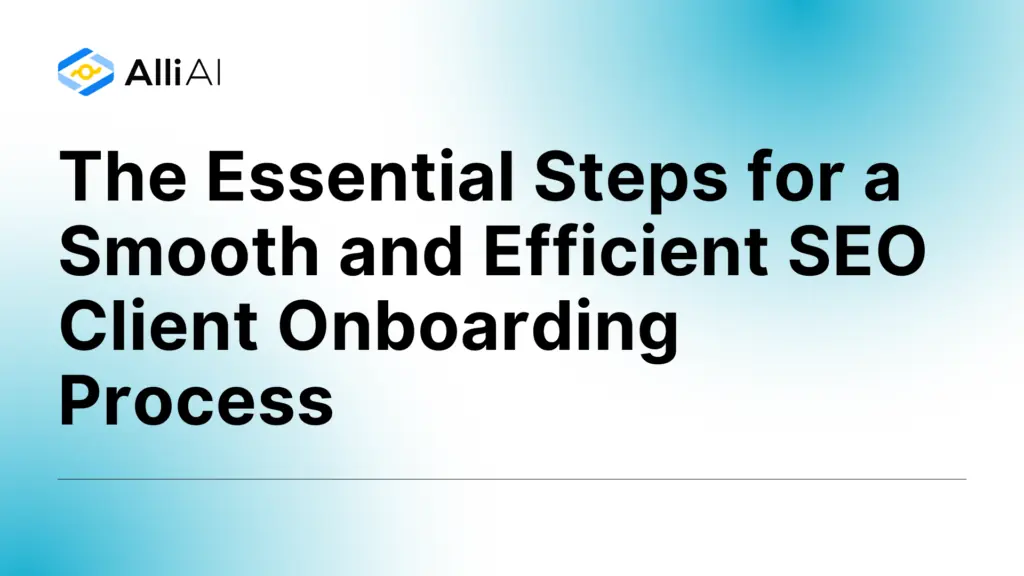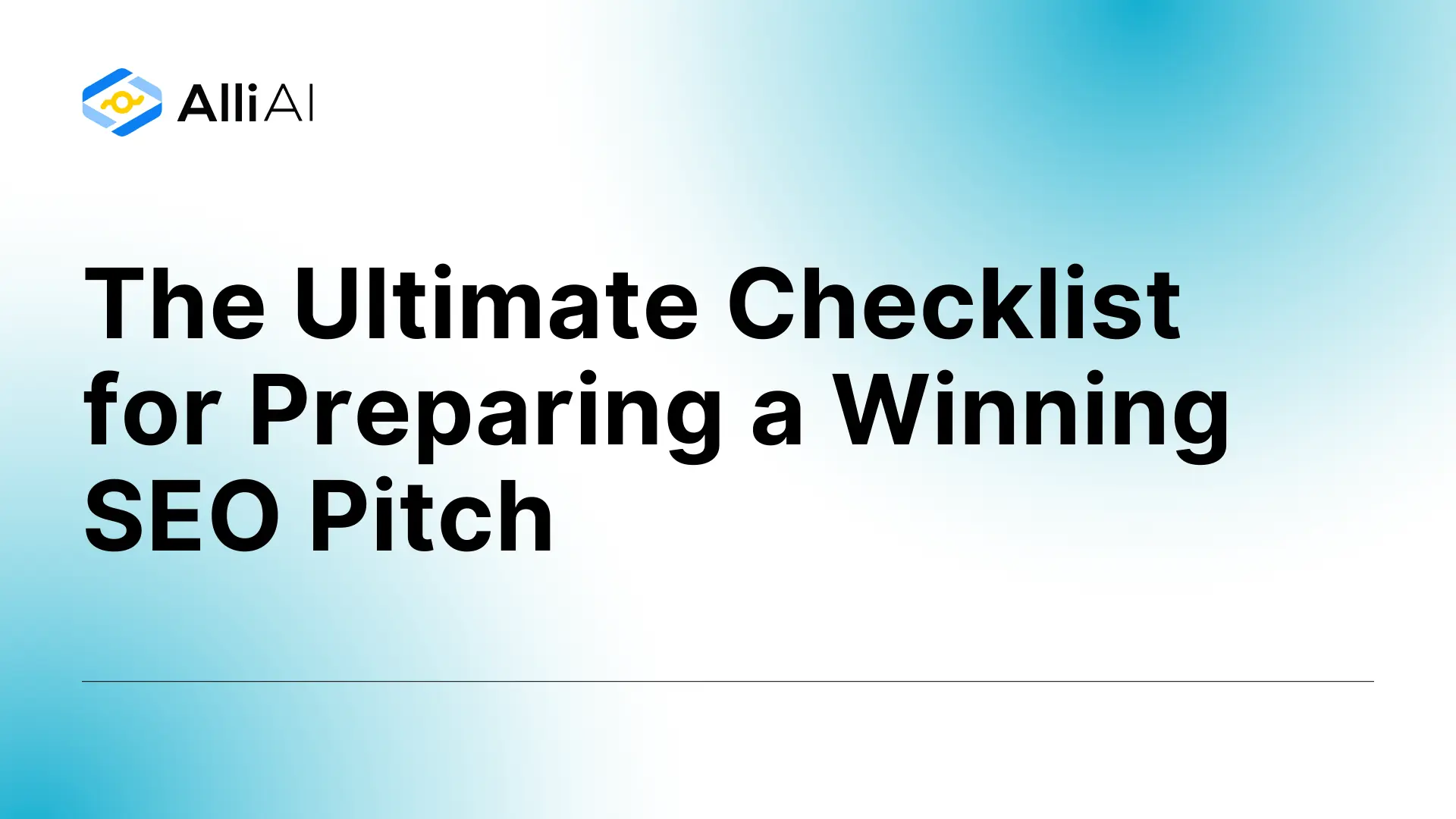Are you struggling to efficiently bring new SEO clients into your agency? The client onboarding process can feel chaotic and overwhelming without a structured approach. The “trick” is to implement a systematic framework that builds trust while gathering all the essential information you need. This is the approach that helped us transform our agency’s client retention rates from just 60% to over 90% in the first year of partnerships.
When I first started handling SEO clients, onboarding was a haphazard process that often led to miscommunications, missed deadlines, and frustrated clients. After refining our approach through dozens of client relationships, we’ve developed a proven system that not only reassures clients they’ve made the right choice but also sets the stage for successful long-term partnerships.
Let me walk you through the exact process we use to onboard new SEO clients smoothly and effectively.
Step #1. Prepare Internally Before Client Contact
Before you send that first welcome email, you need to lay the groundwork internally. This preparation phase is often overlooked but sets the foundation for everything that follows.
Start by researching the client’s business thoroughly. Examine their website structure, current SEO performance, business model, and competitive landscape. I’ve found that spending 2-3 hours on this preliminary research pays enormous dividends throughout the relationship.
Create an internal brief that includes:
- The client’s current organic traffic metrics
- Top performing keywords and content
- Major technical issues visible from external analysis
- Key competitors and their performance
- Industry-specific SEO challenges and opportunities
Next, assign your team members to specific roles for this client. Even if you’re a small agency or solo consultant, clearly defining responsibilities is crucial. Having the right SEO agency tools can make this process much more efficient.
For example, in our agency, we designate:
- A primary account manager (client communication lead)
- An SEO strategist (technical implementation lead)
- Supporting specialists as needed (content, technical, local SEO)
Hold an internal kickoff meeting before any client interaction to ensure everyone understands the client’s goals and expected deliverables. This prevents contradictory messages during client meetings and ensures your team presents a unified approach.
Imagine you’re onboarding a boutique furniture retailer with 20 locations. Your internal research might reveal they have strong brand recognition but poor local SEO implementation. Your team can align on prioritizing Google Business Profile optimization and location-specific content before even meeting the client.
This preparation phase transforms your first client interaction from “getting to know you” to “here’s our informed assessment of your situation and our proposed approach”—immediately demonstrating your expertise.
Step #2. Create a Welcoming First Impression
The first direct contact with your client sets the tone for the entire relationship. Make it count with a thoughtfully prepared welcome packet that combines warmth with professionalism.
Send a personalized welcome email within 24 hours of contract signing. This email should:
- Use the client’s name and reference specific aspects of their business
- Express genuine enthusiasm about the partnership
- Briefly restate the primary objectives of the SEO project
- Outline clear next steps and timing
- Include a comprehensive welcome packet as an attachment
Your welcome email might begin: “Welcome aboard, Sarah! We’re excited to partner with Johnson Furniture on improving your local SEO performance across all 20 locations. Here’s what you can expect over the next two weeks…”
The welcome packet should include:
- A detailed client questionnaire (more on this in Step 3)
- Introduction to team members with photos and brief bios
- Overview of your SEO methodology and approach
- Case studies of similar successful projects
- Communication protocols and expectations
- A clear timeline of the onboarding process
We’ve found that including team member bios with professional headshots significantly improves client comfort levels from the start. Your first impression should convey both expertise and accessibility—you want clients to see you as knowledgeable professionals who are also approachable partners.
The trick is to balance enthusiasm with a structured approach. Clients want to feel both welcomed and reassured that a systematic process is guiding their project forward.
Step #3. Gather Essential Information and Access
Now it’s time to collect the critical information and access credentials needed to execute effective SEO. Without this foundation, your work will be hampered from the start.
First, secure all necessary signed documents. This typically includes:
- The formal client contract
- Any non-disclosure agreements
- Service level agreements
- Authorization forms for accessing platforms
Many agencies use a 3-stage checklist for onboarding new SEO clients to ensure nothing falls through the cracks.
Next, request access to essential digital properties. Create a simple checklist for clients that includes:
- Website admin credentials or user access
- Google Analytics access (Admin level preferred)
- Google Search Console access
- Google Business Profile access (for local SEO)
- Content management system credentials
- Social media accounts (if relevant to SEO strategy)
Your first thought might be to request all these credentials in one email, but I’ve found that breaking this into categories with clear instructions for each platform results in faster, more complete responses.
Beyond technical access, gather comprehensive business information through your questionnaire. This should cover:
- Unique value proposition and differentiators
- Short and long-term business goals
- Available SEO budget and resource constraints
- Target audience demographics and behaviors
- Geographic focus areas
- Competitive landscape
- Previous SEO efforts and outcomes
- Specific KPIs for measuring success
For example, when we onboarded a healthcare provider client, we discovered through our questionnaire that they had attempted SEO previously with disappointing results. This allowed us to address their specific concerns about timeframes and demonstrate how our approach differed from their previous experience.
The questionnaire should be comprehensive but not overwhelming. Break it into logical sections, use multiple-choice options where appropriate, and allow for detailed responses on critical questions. We typically use a digital form tool that allows clients to save progress and return later, recognizing that gathering this information may require input from multiple stakeholders.
Step #4. Set Up Your Project Management Infrastructure
With information and access secured, it’s time to establish the organizational framework that will support the ongoing SEO relationship. Proper project setup is crucial for transparency, accountability, and efficient collaboration.
Add your new client to your preferred project management platform. Whether you use ClickUp, Asana, Basecamp, or another system, create a dedicated workspace for all client-related activities and documents. This is especially important if you’re managing WordPress SEO automation for your clients.
Within this environment:
- Create project folders for different aspects of the SEO campaign
- Set up initial tasks with clear deadlines and ownership
- Upload all relevant documentation (contract, questionnaire responses, etc.)
- Establish recurring tasks for regular activities like reporting
- Set up appropriate client access levels if they’ll be using the platform
I’ve found that providing clients with limited access to the project management system significantly increases their confidence in the process. They can see work progressing in real-time without needing to request updates.
Organize all credentials and access in a secure, centralized location. Use a password management system like LastPass or 1Password for team access to client platforms without sharing actual passwords.
Set up tracking for key performance metrics from day one. Establish baseline measurements for:
- Organic traffic volumes
- Current keyword rankings
- Conversion rates
- Page load speeds
- Indexing status
- Backlink profile metrics
Imagine you’re working with an e-commerce client selling outdoor gear. Your project management setup might include separate folders for technical SEO, content optimization, product page enhancements, and link building—each with specific tasks assigned to different team members with clear deadlines.
The key to effective project management setup is creating a system that balances thoroughness with usability. It should be comprehensive enough to track all essential elements but streamlined enough that team members can easily find what they need without wading through unnecessary complexity.
Step #5. Conduct a Comprehensive Kickoff Meeting
The kickoff meeting is your opportunity to cement the relationship and ensure all stakeholders share a common understanding of the SEO initiative. This meeting should bring together key personnel from both your agency and the client’s team.
Prepare a structured agenda and share it in advance. A typical kickoff meeting agenda includes:
- Team introductions (both agency and client)
- Review of business goals and how SEO objectives support them
- Discussion of the engagement scope and available resources
- Overview of the SEO audit process
- Explanation of the strategic approach
- Timeline review with key milestones
- Communication and reporting expectations
- Q&A session
Use visual aids to enhance understanding. Create a presentation that balances educational content with specific details about the client’s situation. This helps manage expectations while demonstrating your expertise.
Assign a dedicated note-taker to capture all discussions, decisions, and action items. After the meeting, circulate these notes to all participants within 24 hours to ensure alignment.
During the kickoff meeting, balance technical explanations with strategic insights. Remember that clients vary widely in their SEO knowledge—some will want detailed technical discussions while others prefer to focus on business outcomes. Gauge their level of interest and adjust accordingly.
For example, when we kicked off an SEO project with a legal firm, we found they were primarily interested in lead generation metrics rather than technical SEO details. We focused our kickoff discussion on how our technical work would translate to qualified traffic increases and lead conversions.
The most successful kickoff meetings establish clear next steps while building genuine rapport between teams. End the meeting by summarizing key points and confirming immediate action items for both your team and the client.
Step #6. Conduct Strategic Assessment and Planning
Now it’s time to dig deep into the client’s SEO situation and develop a tailored strategy. This phase transforms the information you’ve gathered into an actionable roadmap.
Begin with a comprehensive SEO audit examining:
- Technical performance and issues
- On-page optimization status
- Content quality and gaps
- User experience factors
- Backlink profile strength and weaknesses
- Competitive positioning
- Local SEO performance (if applicable)
A Chicago SEO agency shared that this audit phase is critical for setting realistic client expectations.
Use specialized tools like Screaming Frog, Ahrefs, and Semrush for data collection, but don’t just compile metrics—analyze what they mean in the context of the client’s business objectives.
Develop a prioritized strategy based on audit findings. The most effective SEO strategies balance:
- Quick wins that show immediate value
- Medium-term improvements for steady progress
- Long-term initiatives for sustainable growth
For instance, when we audited a home services company website, we identified critical technical issues preventing proper indexing—a quick fix that immediately improved visibility. This early win built client confidence while we worked on the longer-term content strategy.
Set specific, measurable goals aligned with business objectives. Rather than vague targets like “improve rankings,” establish clear metrics such as:
- Increase organic traffic by X% within Y months
- Achieve first-page rankings for these 20 priority keywords
- Improve conversion rates from organic traffic by Z%
- Reduce bounce rates on key landing pages to under X%
Implementing reliable keyword rank tracking is essential for monitoring these goals.
Your strategic plan should include a clear timeline with milestones that manage client expectations about when results will begin to appear. SEO results aren’t immediate, and clients need to understand the typical progression of improvements.
Document this strategic assessment and plan thoroughly—it will serve as your roadmap throughout the engagement and provide a reference point for measuring progress and success.
Step #7. Establish Clear Communication and Reporting Protocols
The final step in successful onboarding is setting up regular communication channels and reporting mechanisms. Effective communication prevents misunderstandings and keeps the client engaged throughout the SEO process.
Define communication channels for different purposes:
- Regular status updates (often email)
- Urgent issues (perhaps phone or messaging app)
- Strategy discussions (video calls)
- Data sharing (secure document transfers)
Establish clear expectations about response times:
- Same-day responses for urgent issues
- 24-hour turnaround for standard questions
- Scheduled times for non-urgent discussions
Create a customized reporting framework that includes:
- Report frequency (typically monthly)
- Key metrics to be included
- Preferred format (dashboard, PDF, presentation)
- Review method (email, call, in-person)
I’ve found that interactive reporting sessions are far more effective than simply sending documents. We conduct monthly screen-sharing calls where we walk clients through their performance data, explaining trends and answering questions in real-time.
Your reporting should focus on metrics that directly relate to the client’s business goals. For example, an e-commerce client might prioritize conversion data over rankings, while a content publisher might care more about page views and engagement metrics.
Tailor the technical depth of your reports to the client’s expertise and interests. Some clients want detailed technical explanations, while others prefer simplified summaries focused on business impacts. Ask directly about their preferences during onboarding.
For example, for our technology clients with in-house technical teams, we provide detailed reports including server response codes, crawl stats, and rendering issues. For our small business clients, we focus reports on plainly explained metrics like “number of people finding you in Google” and “visitors becoming customers.”
The communication protocol should also include a clear escalation path for any concerns or issues that arise during the engagement.
Wrapping Up: Your Blueprint for SEO Client Success
Creating a systematic onboarding process transforms the client experience from uncertain to confident and sets the stage for a successful long-term partnership. By following these seven steps, you’ll establish clear expectations, gather essential information, and build trust from day one.
Remember that effective onboarding is an investment that pays dividends throughout the client relationship. The time you spend creating structure now will save countless hours addressing misunderstandings later.
The key elements that make this process successful are:
- Thorough internal preparation before client contact
- Professional yet warm first impressions
- Comprehensive information gathering
- Organized project management setup
- Strategic kickoff meetings
- Data-driven assessment and planning
- Clear communication protocols
You’ve now got a complete blueprint for onboarding SEO clients like a seasoned professional. This framework is adaptable to agencies of all sizes—whether you’re a solo consultant or managing multiple teams, these principles will help you create client relationships built on clarity, confidence, and trust.
Implement this process with your very next client and watch how it transforms not just your onboarding experience but the entire client relationship that follows.






